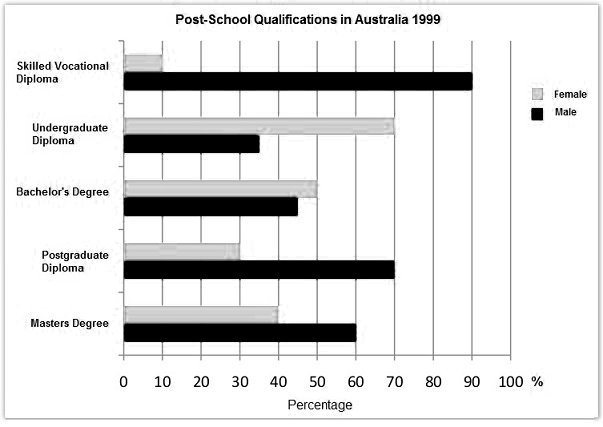Writing Task 1
You should spend about 20 minutes on this task.
The chart below shows the different levels of post-school qualifications in Australia and the proportion of men and women who held them in 1999.
Summarise the information by selecting and reporting the main features, and make comparisons where relevant.
Write at least 150 words.

Writing Task 2
You should spend about 40 minutes on this task.
Write about the following topic:
Creative artists should always be given the freedom to express their own ideas (in words, pictures, music or film) in whichever way they wish. There should be no government restrictions on what they do.
To what extent do you agree or disagree with this opinion?
Give reasons for your answer and include any relevant examples from your own knowledge or experience.
Write at least 250 words.
Cambridge IELTS 4 Academic Writing Test 3 Task 1 Model Answer (154 words)
The chart gives information about post-school qualifications in terms of the different levels of further education reached by men and women in Australia in 1999.
We can see immediately that there were substantial differences in the proportion of men and women at different levels. The biggest gender difference is at the lowest post-school level, where 90% of those who held a skilled vocational diploma were men, compared with only 10% of women. By contrast, more women held undergraduate diplomas (70%) and marginally more women reached degree level (55%).
At the higher levels of education, men with postgraduate diplomas clearly outnumbered their female counterparts (70% and 30%, respectively), and also constituted 60% of Master’s graduates.
Thus we can see that more men than women hold qualifications at the lower and higher levels of education, while more women reach undergraduate diploma level than men. The gender difference is smallest at the level of Bachelor’s degree, however.
Cambridge IELTS 4 Academic Writing Test 3 Task 2 Model Answer (339 words)
The issue of whether creative artists should be granted unrestricted freedom to express their ideas is a topic of significant debate. I contend that while creative freedom is essential for the flourishing of arts, some level of governmental regulation is necessary to balance individual expression with broader societal concerns.
Unrestricted creative freedom is vital for the development of innovative and impactful art. Historically, many masterpieces have emerged from periods when artists were allowed to push boundaries and challenge prevailing norms. For example, the Renaissance period in Europe saw an explosion of artistic creativity partly because of the relative freedom artists had to explore new ideas and techniques. Similarly, modern music and film often thrive on the ability to explore controversial and thought-provoking themes, which can stimulate public discourse and drive social change.
Moreover, art serves as a reflection of society, capturing diverse perspectives and experiences. Limiting artistic expression can stifle cultural development and prevent society from grappling with complex issues. For instance, artists who tackle themes such as political corruption or social injustice provide a crucial critique that can lead to reform and improvement. Without the freedom to explore these themes, art becomes sterile and loses its power to inspire and challenge audiences.
However, complete freedom without any oversight can lead to the proliferation of content that is harmful or offensive. Governments have a duty to protect public order and moral standards, which sometimes necessitates regulation. For example, hate speech or content that incites violence can have detrimental effects on social cohesion and safety. In such cases, government intervention is justified to prevent harm. The challenge lies in ensuring that regulations are not used to suppress dissent or minority viewpoints but rather to maintain a balance between freedom of expression and societal well-being.
In conclusion, while creative freedom is crucial for the growth and impact of the arts, some level of government regulation is necessary to prevent potential harm and maintain social harmony. The key is to implement regulations that protect public interests without stifling artistic innovation and expression.
Leave a Reply